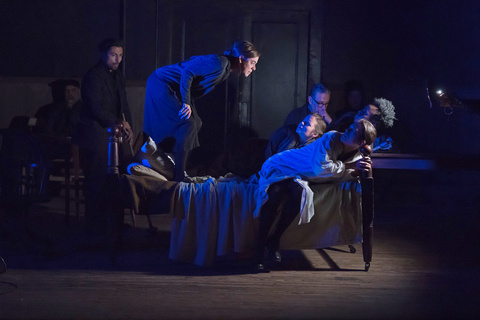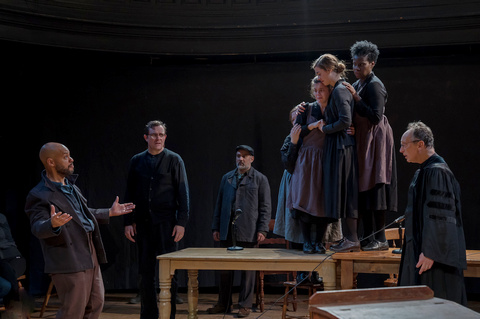The Crucible (Bedlam)
Riveting production of the Arthur Miller tragedy proves to be relevant once again in the time of Trump.

Truett Felt as Abigail Williams (far left) and the Cast of Bedlam’s “The Crucible” at The Connelly Theater (Photo credit: Ashley Garrett)
[avatar user=”Victor Gluck” size=”96″ align=”left”] Victor Gluck, Editor-in-Chief[/avatar]
As produced by Bedlam in association with The Nora, Arthur Miller’s 1953 tragedy, The Crucible, based on the Salem Witch Trials proves to be both riveting and relevant all over again. In the past, the play was seen as a cautionary tale about the McCarthy Era witch hunt that destroyed so many lives. Now in 2019 it becomes a story of truth and lies, fiction and fact. One of the judges refers to the situation in Salem as “this swamp.” In the age of Trump, Miller’s play has new meaning for our time. You could hear a pin drop during Eric Tucker’s unfussy production which becomes more and more scary as the Salem witch trials progress and the townspeople become entirely carried away by the hysteria.
For those who don’t know The Crucible or the history of the Salem Witch Trial (1692-93), according to Miller’s (partly fictitious as well as partly based on period transcripts) play Reverend Parris has come upon his daughter Betty, his slave Tituba from Barbados, his niece Abigail Williams and a group of other Salem girls irreligiously dancing around a caldron in the woods. Betty falls into a coma and the other girls spurred on by Abigail claim to be possessed by the devil and accuses several local women of being witches. Judge Hathorne and Deputy Governor Danforth are brought to Salem to convene a special court. The hysteria mounts as many suspicious and resentful townspeople use this as an opportunity to take revenge on their neighbors (those wanting the land adjacent to their property, accusations that stillborn children were the work of witches, etc.) Eventually, 200 people are in prison awaiting trial.
However, when John Proctor’s saintly wife Elizabeth is accused for keeping a poppet (a doll-like puppet) which was given to her by her servant Mary Warren, one of the girl witnesses, at the behest of Abigail, he knows it is time for him to speak up. Eight months earlier, his wife puts Abigail out on the road when she discovered that her husband and servant were having a carnal relationship behind her back. Abigail is under the impression that if Elizabeth were out of the way John would marry her. John denounces Abigail but not before he is caught up in the hysteria for not attending church as he believes Rev. Parrish to be a very greedy, ungodly man. Eventually many of the court officers fear for their own safety as the tide turns and townspeople begin to doubt the truth of the accusations but not before some innocent people have been found guilty and hanged.

Ryan Quinn as John Proctor (far left) and the Cast of Bedlam’s “The Crucible” at The Connelly Theater (Photo credit: Ashley Garrett)
Bedlam is known for its radical reinterpretations of classic works. Except for the first scene which is very presentatal with characters suddenly addressing the audience and one actor playing several roles, Tucker’s version of The Crucible is rather conventional other than its design and some of its technology. In John McDermott’s radical set design, The Connelly Theatre has been gutted and the main auditorium used as the central playing area. Some audience members sit in a single row three-quarters of the way around the playing area, with the rest of the audience nearby on bleachers on the original stage of the theatre. This very closeness make the viewer both a ring-side witness and also complicit in the events of the play.
Much of Les Dickert’s arresting lighting design is created by the use of handheld lights that generate a dark, candlelight effect, perfect for its 1692-93 setting. The minimal use of furniture is in keeping with the historical period of these strict, religious people who had difficult lives. During the trial scene, actors playing the girl witnesses on table mikes give a ghostly feeling to their fake testimony. Tucker has also included Act II, Scene 2, a chilling confrontation between John and Abigail the day before his testimony, which is usually cut but proves to be quite dramatic, although not entirely necessary.
From the vigorous direction and the committed acting, the tension builds to tremendous pitch. Ryan Quinn’s John Proctor is passionate and dynamic. As Elizabeth, his wife, Susannah Millonzi is chillingly icy though very fair minded. Truett Felt as the devious Abigail proves to be the arrogant, deceitful young woman we come to know that she is. Randolph Curtis Rand’s Reverend Parris is self-serving and naïve, just the right person to set the hysteria in motion. As Deputy Governor Danforth, Paul Lazar is a formidable figure, though obviously limited in scope and biased in favor of the accusations.

Susannah Millonzi as Elizabeth Proctor, Eric Tucker as Reverend Hale and Alan Altschuler as Frances Nurse in a scene from Bedlam’s “The Crucible” at The Connelly Theater (Photo credit: Ashley Garrett)
As the revengeful and covetous Putnams, Arash Mokhtar and Zuzanna Szadkowski are very amusing as a self-righteous couple out to feather their own nest. Shaun Taylor-Corbett is chilling as Cheever, the clerk of the Salem’s General Court, as he finds legal reasons to betray his own friends. Rajesh Bose is amusing as the stingy Giles Corey who is always suing his neighbors and playing his own lawyer to save money. Alan Altschuler is upright as Francis Nurse whose integrity soars above many of the others.
Using only a cast of 14, some doubling is necessary but is performed so well that it is usually difficult to recognize the actors who play multiple roles. Szadkowski is very different as matron Ann Putnam, teenage girl Susanna Walcott, and the homeless Sarah Good. Aside from Elizabeth Proctor, Millonzi also appears as catatonic Betty Parrish in the first act. Mokhtar changes from the hypocritical Putnam to the authoritarian Judge Hathorne. Some of the other doubling is accomplished with clever costuming. (While the programs are not given out until the end of the play as at several companies, list all the actors as members of the “Ensemble” does disservice to their fine work in this production.) Except for the women’s long skirts, Charlotte Palmer-Lane’s dark costumes could be worn today but are neither distracting nor inappropriate for these country folk.
Eric Tucker’s production of The Crucible is as exciting and cautionary as it has ever been in the past but the brisk, spirited, totally convincing performances give this an added dimension. So too do the modern parallels: beware those who use lies and deceit to gain the things of this world. Arthur Miller would be most impressed with this revival as you will be too. Some plays need to be seen again and again to remind us of their message.
The Crucible (through December 29, 2019)
Bedlam in association with The Nora
The Connelly Theater, 220 E. 4th Street, in Manhattan
For tickets, visit http://www.Bedlam.org
Running time: three hours and five minutes with one intermission






Leave a comment